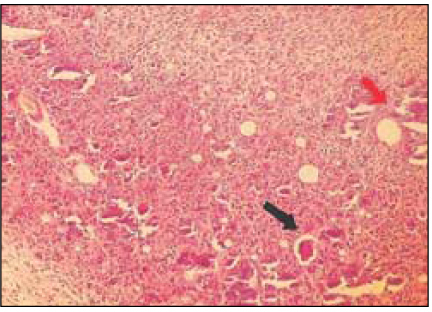J Korean Acad Conserv Dent.
2004 Jan;29(1):23-29. 10.5395/JKACD.2004.29.1.023.
Tissue reactions to implanted intracanal medicaments in rats
- Affiliations
-
- 1Department of Dentistry, Asan Medical Center, Seoul, Korea. kmr333@unitel.co.kr
- KMID: 1987080
- DOI: http://doi.org/10.5395/JKACD.2004.29.1.023
Abstract
- No abstract available.
Figure
Reference
-
1. Lewis BB, Chestner SB. Formaldehyde in dentistry: a review of mutagenic and carcinogenic potential. J Am Dent Assoc. 1981. 103:429–434.
Article2. Foreman PC, Barnes F. A review of calcium hydroxide. Int Endod J. 1990. 23:283–297.
Article3. Spangberg L, Rutherg , Rydinge . Biological effect of endodontic antimicrobial agents. J Endod. 1979. 5:166–175.4. Araki K, Isaka H, Ishii T, Suda H. Excretion of 14C-formaldehyde distributed systemically through root canal following pulpectomy. Endod Dent Traumatol. 1993. 9:196–199.
Article5. Hermann BW. Calciumhydrxyd als Mittel zum Behandel und Fullen von Zahnwur zel kanalen. 1920. 09. V 29. Wurzburg: Med Diss.6. Sjogren U, Figdor D, Spanberg L, Sundqvist G. The antimicrobial effect of calcium hydroxide as a short-term intracanal dressing. Int Endod J. 1991. 24:119–125.
Article7. Safavi KE, Nichols FC. Alteration of biological properties of bacterial lipopolysacchride by calcium hydroxide treatment. J Endod. 1994. 20:127–129.
Article8. Safavi KE, Spanberg L, Langerland K. Root canal dentinal tubule disinfection. J Endod. 1990. 16:207.
Article9. Kontakiotis E, Nakou M, Georgopoulou M. In vitro study of the indirect action of calcium hydroxide on the anaerobic flora of the root canal. Int Endod J. 1995. 28:285–289.
Article10. Siqueira JF, Lopes HP. Mechanisms of antimicrobial activity of calcium hydroxide: a critical review. Int Endod J. 1999. 32:361–369.
Article11. Pettis GY, Kaban LB, Glowacki J. Tissue response to composite ceramic hydroxyapatite/Demineralized bone implants. J Oral Maxillofac Surg. 1990. 48:1068–1074.
Article12. Tavares T, Soares IJ, Silveira NL. Reaction of rat subcutaneous tissue to implants of gutta-percha for endodontic use. Endod Dent Traumatol. 1994. 10:174–178.
Article13. Torabinejad M, Pitt Ford TR, Abedi HR, Kariyawasam SP. Tissue reaction to implanted root-end filling materials in the tibia and mandible of guinea pigs. J Endod. 1998. 24(7):468–471.
Article14. Madison S, Anderson RW. Medications and temporaries in endodontic treatment. Dent Clin North Am. 1992. 36:343–356.15. Block RM, Lewis RD, Sheats JB, Burke SG, Richmond VA. Antibody formation to dog pulp tissue altered by formocresol within the root canal. Oral Surg Oral Med Oral Pathol. 1978. 45:282–292.
Article16. Martin H, et al. Permeability of the apical third of the root to drugs used in endodontic therapy: an in vitro study. J Oral Ther Pharmacol. 1968. 4:451–455.17. Moon HI, et al. Pulpal and Periapical Reaction to Formocresol and Depulpin® in the Rat Tissue. J Korean Acad Conserv Dent. 2002. 27:355–362.
Article18. Yang SF, Rivera EM, Baumgardner KR, Walton RE, Stanford C. Anaerobic Tissue-dissolving abilities of calcium hydroxide and sodium hypochlorite. J Endod. 1995. 21:613–616.
Article19. Foster KH, Kulild JC, Weller RN. Effect of smear layer removal on the diffusion of calcium hydroxide through radicular dentin. J Endod. 1993. 19:136–140.
Article20. Katebzadeh N, Hupp J, Trope M. Histological periapical repair after obturation of infected root canals in dogs. J Endod. 1999. 25:364–368.
Article21. Huang FM, Tai KM, Chou MY, Chang YC. Cytotoxicity of resin-, zinc oxide-, and calcium hydroxide-based root canal sealers on human periodontal ligaments cells and permanent V79 cells. Int Endod J. 2002. 35(2):153–158.
Article22. Masatsugu I, Yasuharu Y, Masahiro M, Teruo A. Bone regeneration produced in rat femur defects by polymer capsules containing recombinant human bone morphogenetic protein-2. J Oral Maxillofac Surg. 1999. 57:695–698.
Article23. Rodgers JB, Vasconez MD, Wells MD, Deruca PP, Faugere MC, Fink BF, Hamilton D. Two lyophilized polymer matrix recombinant human bone morphogenetic protein-2 carriers in rabbit calvarial defects. J Craniofac Surg. 1998. 9:147–153.
Article24. King GN, King N, Hughes FJ. Effect of tow delivery systems for recombinant human bone morphogenetic protein-2 on periodontal regeneration in vivo. J Periodont Res. 1998. 33:226–236.
Article25. Uludag H, Darren D, Janet G, Jian Li, Wozney JM. Implantation of recombinant human bone morphogenetic proteins with biomaterial carriers: A correlation between protein pharmacokinetics and osteoinduction in the rat ectopic model. J Biomed Mater Res. 2000. 50:227–238.
Article
- Full Text Links
- Actions
-
Cited
- CITED
-
- Close
- Share
- Similar articles
-
- Effect of Intracanal Medicaments on Push-out Bond Strength of Calcium Silicate-based Materials
- Discoloration of teeth due to different intracanal medicaments
- Effect of intracanal medicaments used in endodontic regeneration procedures on microhardness and chemical structure of dentin
- Evaluation of the rat tissue reaction to experimental new resin cement and mineral trioxide aggregate cement
- Effect of hydrogel-based antibiotic intracanal medicaments on crown discoloration








